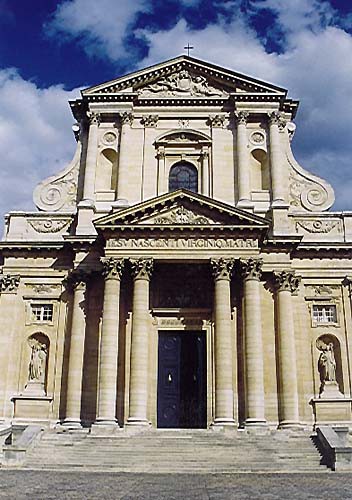The magnificent ensemble of Val-de-Grâce is the architectural symbol of excellence in military medecine. With its army medical school and army medical museum containing archives and library, and with the new military hospital comprising 13 specialist clinics, it represents a complete centre of medical expertise.
The church of Val-de-Grâce was commissioned by Anne of Austruia in 1638 as part of a vow which she had made for the safe delivery of her son, the future Louis XIV. The building, of Roman Baroque inspiration, was begun by François Mansart and finished by Le Mercier, Le Muet and Le Duc. In 1665, work was begun on the convent adjoining the church, and it is the convent building which today houses the Musée du Service de Santé des Armées (Museum of the Army Medical Corps). Deconsacrated in 1790, Val-de-Grâce was officially handed over to the army by a decree of 31 July 1793, and in 1795 it was transformed by the Convention into a military training hospital. Opened in 1796, the hospital became the Ecole d'application du Service de santé militaire founded by a decree dated 9 August 1850. And all the great French military doctors, from Larrey and Percy to Vincent, passed through its imposing portals.
The museum traces its origins back to the 19th century. At first merely an anatomy collection for teaching purposes, it gradually grew as a result of bequests – one from Hippolyte Larrey (1808-1895) brought in many books and objects owned by his famous father (notably, a sword given by Napoleon after the Battle of Eylau, paintings, uniforms, etc.) – to become the repository of army medical corps history. The restoration of the building and museum was begun in 1990 and the inauguration of part of the refurbished site (notably the temporary exhibition halls) was held in 1993 on the two-hundredth anniversary of the installation of the army medical corps at Val-de-Grâce – the permanent exhibition halls were opened to the public at the beginning of 1998.
Visitors enter the museum via a splendid Louis XIII staircase which leads to the first floor of the convent. The visit is then skilfully structured around four sections. The first deals specifically with the development of the army medical corps from the Revolutionary and First Empire periods up to the present day. There is a part dedicated entirely to Baron Dominique Larrey (1766-1842), professor of clinical surgery at Val-de-Grâce, head surgeon of the Garde Impériale and later of the Grande Armée, Inspecteur du Service de Santé and member of the Académie de médicine. Items on show include reports of 37 years of service, his doctoral thesis defended in 1786, his uniform, his medical bag, the sword of honour given to him by Napoleon after Eylau – the first sword of honour ever awarded to an officer of the medical corps – a scale model of his famous 'flying ambulance', etc. Next the viewer is plunged into the Second Empire by a full-size reconstruction of a surgical anatomy lesson at the Ecole d'application de la Médecine impériale. Here there are surgeon, doctor and vet uniforms, arms and decorations. Of interest is a series gouaches painted in 1917 by Jean-Dominique Benderly, conscripted to Val-de-Grâce during the First World War, documenting the history of the uniforms of the doctors, surgeons, pharmacists and administrative officers of the medical corps. There then follows a detailed view of the corps' support role to the armed forces, notably: first aid and retrieval of the wounded (including a painting by Jules Rigo showing Napoleon III visiting the wounded from the Battle of Montebello at the ambulance in Voghera during the Italian campaign in May 1859); a first-aid post ('Baron Larrey in an ambulance during the battle of Eylau'); a sorting centre; evacuations; field hospitals and army hospitals.
The second section of the museum gives a presentation of scientific research within the army medical corps. The Napoleonic wars led to significant surgical advances, although in the most appalling of conditions. Trepanning and amputation were part of a doctor's daily wretched tasks (there is a painting entitled 'Dominique Larrey performing an amputation on Captain Rebsomen at the Battle of Hanau (30 October 1813)'). Others practised more preservative surgery (for example, Pierre-François Percy, 1754-1825 – the museum possesses a bust of Percy by David d'Angers). Anasthetics, blood transfusion, radiology and psychiatry, etc., were all medical specialisations in which, sadly, armed conflict brought about progress. The third section of the museum illustrates the role which the army medical corps played in the world of civilian health and the fourth section takes hygiene and infectious diseases as its subjects. These three themes are dealt with in great detail, including exceedingly high quality audio-visual exhibits.
Museum of the Army Service de Santé Medical Corps – Val-de-Grâce


